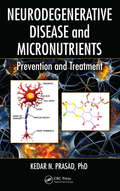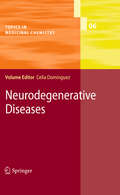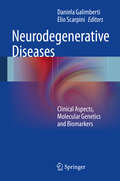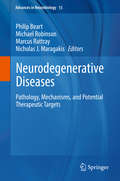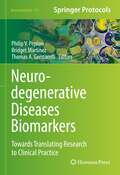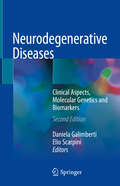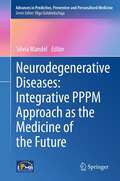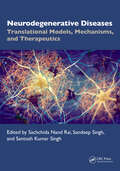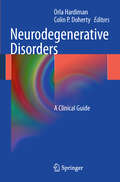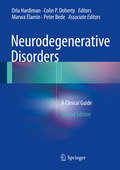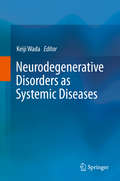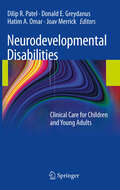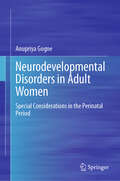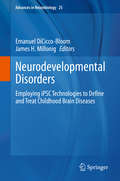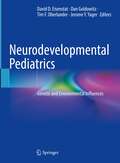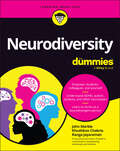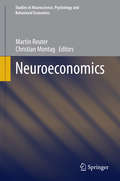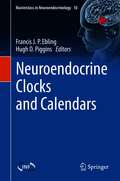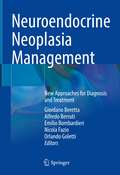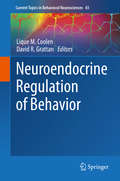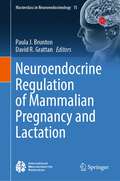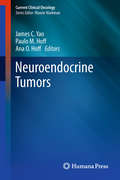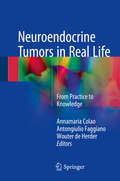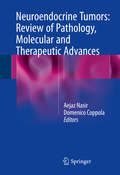- Table View
- List View
Neurodegenerative Disease and Micronutrients: Prevention and Treatment
by Kedar N. PrasadThe book proposes that a preparation of antioxidants and micronutrients, in combination with standard therapy, may reduce progression and improve management better than standard therapy alone for Alzheimer's, Parkinson's, and Huntington's disease, as well as PTSD, traumatic brain injury, concussions, and cerebral vascular insufficiency. The book pr
Neurodegenerative Diseases
by Celia DominguezThe Role of Histone Deacetylases in Neurodegenerative Diseases and Small-Molecule Inhibitors as a Potential Therapeutic Approach.- Phosphodiesterase Inhibition to Target the Synaptic Dysfunction in Alzheimer's Disease.- Glutamate and Neurodegenerative Disease.- Modulation of the Kynurenine Pathway for the Potential Treatment of Neurodegenerative Diseases.- Spinal Muscular Atrophy: Current Therapeutic Strategies
Neurodegenerative Diseases
by Daniela Galimberti Elio ScarpiniThis book gives an overview of the current knowledge on the most common neurodegenerative diseases, including Alzheimer's disease, frontotemporal lobar degeneration, amyotrophic lateral sclerosis, and additional neurodegenerative diseases. Different aspects of each disease are reviewed, including clinical issues, treatments, basic discoveries (genetics and molecular biology), and translation of basic research into biomarkers for early diagnosis. In addition, emerging data indicate that neurodegeneration seems to also be present in classically non-degenerative disorders. Therefore, a chapter about overlapping mechanisms between dementias and psychiatric disorders is included, as well as a description of the role of neurodegeneration in multiple sclerosis. Neurodegenerative Diseases is aimed at clinicians, particularly those working in academic hospitals. This multidisciplinary book will also be of interest to basic researchers in medical fields.
Neurodegenerative Diseases
by Michael Robinson Philip Beart Marcus Rattray Nicholas J. MaragakisProvides a timely overview of critical advances in molecular and cellular neurobiology, covers key methodologies driving progress, and highlights key future directions for research on neuronal injury and neurodegeneration relevant to neuronal brain pathologies. The editors bring together contributions from internationally recognized workers in the field to provide an up to date account of how and why molecular and cellular neurobiology is such an important area for clinical neuroscience. Understanding the molecular aspects of a number of neurodegenerative conditions such as Parkinson's or Alzheimer's disease for the purpose of improving patient management remains a major challenge of neurobiology be it from the basic or clinical perspective. A strategic evaluation of research contributions and the power of modern methods will help advance knowledge over the next years.
Neurodegenerative Diseases Biomarkers: Towards Translating Research to Clinical Practice (Neuromethods #173)
by Philip V. Peplow Bridget Martinez Thomas A. GennarelliThis volume presents recent data on the latest achievements in new and emerging technologies for biomarkers and for innovations in their assessment. The chapters cover topics such as activation of microglia and macrophages in neurodegenerative diseases; oxidative stress and cellular dysfunction in neurodegenerative diseases; TSPO PET imaging as a biomarker of neuroinflammation in neurodegenerative disorders; and imaging biomarkers in Huntington's disease and amyotrophic lateral sclerosis. In the Neuromethods series style, chapters include the kind of detail and key advice from the specialists needed to get successful results in your laboratory. Cutting-edge and comprehensive, Neurodegenerative Diseases Biomarkers: Towards Translating Research to Clinical Practice is a valuable resource for both experimental and clinical experts in the field of neurodegenerative diseases who are looking to expand their knowledge of novel biomarkers in different types of neurodegenerative diseases.
Neurodegenerative Diseases: Clinical Aspects, Molecular Genetics And Biomarkers
by Daniela Galimberti Elio ScarpiniThis book gives an overview of the current knowledge on the most common neurodegenerative diseases, including Alzheimer’s disease, frontotemporal lobar degeneration, Lewy body dementia,Parkinson’s disease, amyotrophic lateral sclerosis, and additional less common neurodegenerative diseases. Both clinical and basic aspects of each disease are treated, including novel diagnostic criteria, old and new treatments, basic discoveries (genetics, epigenetics and molecular biology), and translation of basic research into biomarkers for early diagnosis, particularly to identify peripheral biomarkers. In addition, emerging data indicate that neurodegeneration seems to also be present in classically non-degenerative disorders. Therefore, a chapter about overlapping mechanisms between dementias and psychiatric disorders is included, as well as a description of the role of neurodegeneration in multiple sclerosis.Neurodegenerative Diseases is aimed at clinicians, particularly those working in academic hospitals. This multidisciplinary book will also be of interest to basic researchers in medical fields.
Neurodegenerative Diseases: Integrative PPPM Approach as the Medicine of the Future
by Silvia MandelThis book will compile a collection of chapters dedicated to varied aspects of PPPM in neuropsychiatric and neurodegenerative diseases. Among the topics to be covered are: Recent advances in ALS research News about Clinical aspects and advanced therapy approaches in personalized treatment of ALS Schizophrenia: New treatments and clinical aspects Predictive, Preventive and Personalised Medicine in aging macular degeneration Advances in Multiple Sclerosis Pharmacogenetics, Tailoring Treatment Efficacy, Safety and Regimen Selection Multiple sclerosis related biomarkers: perspectives for clinical application Preventive clinical trials in brain aging: new trends & the need of guidelines MCI_ clinical guidelines in early diagnosis of dementia Alzheimer's disease: diagnostics, prognostics and the road to prevention Biomarkers for early diagnosis of Parkinson's and Alzheimer's diseases Synucleinopathies, tauopathies, TDP-43 proteinopathies and amyloidosis PSP, MSA and other parkinsonisms
Neurodegenerative Diseases: Translational Models, Mechanisms, and Therapeutics
by Sandeep Singh Santosh Kumar Singh Sachchida Nand RaiThis reference book provides a comprehensive overview of models and therapeutic approaches against neurodegenerative diseases, including Parkinson’s disease, Alzheimer’s disease, Huntington’s disease, and amyotrophic lateral sclerosis. It explores models based on the chemical, induced, cellular, genetic, transgenic, and 3D organoid approaches in neurodegenerative diseases. The book also reviews advantages and limitations of these models in designing the treatment strategies. Additionally, the book covers the emerging field of bioinformatics and its application in modeling various neurodegenerative diseases. Towards the end, the book highlights the role of holistic management, precision medicine, OMICS, and gene therapy against neurodegenerative disorders. It examines the implications and significance of stem cells therapy in translational models of neurodegenerative diseases. This book is an invaluable resource for researchers, neuroscientists, and neurosurgeons for getting in-depth information on the neurodegenerative models and therapeutic approaches.Key Features: Provides a comprehensive overview of neurodegenerative diseases and their models Examines the limitations associated with modeling neurodegenerative diseases Presents novel treatment strategies for Alzheimer's disease using cellular models Reviews importance of 3D organoid models for therapeutic approaches in Parkinson's disease Covers modeling techniques in understanding prion diseases Explores the role of genetic models in understanding Huntington's disease
Neurodegenerative Disorders
by Colin P. Doherty Orla HardimanNeurodegenerative Disorders provides an accessible guide to the commonest neurodegenerative diseases, outlining the main clinical features, treatment options and outcomes of the conditions most frequently encountered in clinical practice. Beginning with an overview of the general principles that underlie degeneration, and the contribution of established and new diagnostics techniques, the book goes on to describe the most common neurodegenerative conditions including Alzheimer Disease; Dementia and Cerebrovascular Disease; Parkinson's Disease; Fronto-Temporal Dementia; Amyotrophic Lateral Sclerosis; Huntington's Disease; Parkinsonism Plus syndromes and Prion Diseases. Final chapters cover important management issues including the use of palliative care strategies, advance directives and competence. Written by experts in the field internationally Neurodegenerative Disorders is a practical guide for clinicians that will be indispensable for the management of these conditions.
Neurodegenerative Disorders
by Colin P. Doherty Orla Hardiman Marwa Elamin Peter BedeThis new edition provides an accessible guide to the commonest neurodegenerative diseases, outlining the main clinical features, treatment options and outcomes of the conditions most frequently encountered in clinical practice. Beginning with an overview of the general principles that underlie degeneration, and the contribution of established and new diagnostics techniques, the book goes on to describe the most common neurodegenerative conditions and, new for the second edition, also HIV dementia and multiple sclerosis. Final chapters cover important management issues including the use of palliative care strategies, biomarkers and neuropsychology. Written by experts in the field internationally Neurodegenerative Disorders, Second Edition is a practical guide for clinicians that will be indispensable for the management of these conditions.
Neurodegenerative Disorders as Systemic Diseases
by Keiji WadaThis book sheds new light on neurodegenerative disorders as systemic diseases. Classically, neuronal cell death was a hallmark of such disorders. However, it has become evident that neural dysfunction is more important in the pathophysiology of neurodegenerative disorders. More recently, the prionoid-spreading hypothesis of disease-causing molecules has attracted a great deal of attention. Therapeutic strategies thus must be reconsidered in the light that neurodegenerative disorders are indeed systemic diseases. The first part of this book introduces the concept of neurodegeneration in biology and pathophysiology. The second part focuses on clinical evaluation and biomarkers from the perspective of this new concept, while the third summarizes the risk factors of neurodegeneration. The fourth part of this work indicates future directions of treatment, and the final part discusses health promotion for prevention and quality of life. This book will be of interest to both researchers and medical personnel, and provides a fresh approach to neurodegenerative diseases, paving the way to new research and improved quality of health care for patients.
Neurodevelopmental Disabilities: Clinical Care for Children and Young Adults
by Donald E. Greydanus Dilip R. Patel Hatim A. Omar Joav MerrickIncreasingly more and more children with developmental disabilities survive into adulthood. Pediatricians and other clinicians are called upon to care for an increasing number of children with developmental disabilities in their practice and thus there is a need for a practical guide specifically written for paediatricians and primary care clinicians that addresses major concepts of neurodevelopmental pediatrics. In the United States, the specialty training leading to a conjoint board certification by the American Board of Pediatrics and American Board of Psychiatry and Neurology, requires a total of 6 years of training (2 years of pediatrics, 1 year of neurology, 18 months of child neurology, 18 months of neurodevelopmental disabilities). As of December 2006, in the US, there were 241 pediatricians and 55 child neurologists certified in the subspecialty of Neurodevelopmental Disabilities. Thus most of the children with developmental disabilities are seen by pediatricians and therefore it is important for these pediatricians to be well informed of common issues in the field. The 60,000 or so pediatricians in the United States (and hundreds more in other countries) are the main target audience for a practical book on neurodevelopmental pediatrics.
Neurodevelopmental Disorders in Adult Women: Special Considerations in the Perinatal Period
by Anupriya GogneThis book elaborates on Neurodevelopmental Disorders (NDD) and their treatment in adult women with a special focus on the unique clinical presentation of these problems during the Perinatal period. Problems related to chronic, untreated NDD during adulthood are viewed through the lens of pregnant and postpartum mothers to highlight unique struggles as their family unit expands after having children. The content is based on the author&’s clinical experience with mothers under her psychiatric care between 2017-2024 at an outpatient practice, affiliated with Brown University. Comorbid psychiatric problems such as anxiety, mood disorders, trauma and substance use disorders are also reviewed. In addition to sharing clinical anecdotes, the author presents a consolidated review of scientific literature on the subject. I believe that this book can be an important addition to scientific literature at this time, when Neurodiversity is being explored and accepted more in society and we are more receptive to improving women&’s mental health. Afflicted mothers as well as their treatment providers have conveyed to me the profound relief on finally getting accurate diagnosis and treatment for NDDs. Several books have been published documenting the unique presentation and treatment interventions for ADHD and Autism in women, however, this will be the only book addressing symptomology and treatment interventions for NDD specifically during the perinatal period. I have seen how successful long-term treatment with a specialized team of mental health professionals can significantly improve the quality of life not just for the mother but also, for the entire family unit. The book will be divided into two parts: Part 1- Clinical Manifestations and Symptomology in Adult Women with NDD In the first part of the book, I plan to discuss the approach to diagnosis of Neurodevelopmental Disorders in General Adult Psychiatry and understand reasons for missed diagnosis, especially in females. I will outline my diagnostic and therapeutic approach, conceptualizing NDDsymptomology as variations of higher brain functioning rather than categorization of these symptoms as a &“disorder,&” and contemplating potential evolutionary advantages to neurodiversity. Based on my clinical practice, I will discuss tools for clinical assessment, including referral for neuropsychological testing and its utility in adults. In addition to the DSM-5 diagnoses, I will also propose conceptualizing difficulties in functioning and subjective distress in terms of symptom domains (executive dysfunction, hyperactivity/impulsivity, sensory overload and emotional regulation) as reflected in day-to-day functioning and social interactions in the adult life of women. Also, differential diagnoses including Obsessive Compulsive Disorder, Bipolar disorder, Post Traumatic Stress Disorder (PTSD), and personality disorders will be discussed, addressing the puzzling symptom overlap as well as genetic predisposition between these psychiatric illnesses and neurodevelopmental disorders. I will describe this association using clinical case examples and, later in the book, propose the inclusion of trauma-based interventions in treatment of Neurodevelopmental Illnesses in adult women. Lastly, comorbid substance use will be addressed. I will highlight struggles related to complex psychopathology and dual diagnosis. Given my training in Addiction Psychiatry, one of my goals is also to reduce stigma and apprehension about prescribing controlled medications in patients with history of substance use disorders. Part 2- Perinatal perspective on NDD Part 2 will have a specific perinatal focus starting with a detailed description of predisposing factors (Behavioral/Social, Psychological and Biological factors) for distress in Mothers with
Neurodevelopmental Disorders: Employing iPSC Technologies to Define and Treat Childhood Brain Diseases (Advances in Neurobiology #25)
by Emanuel DiCicco-Bloom James H. MillonigThis book contains a compendium of induced pluripotent stem cells (iPSCs) articles and reviews concerning state of the art technologies and how they are being applied to human neurodevelopmental disorders. With the establishment of effective technologies to produce iPSCs and their derivatives, like neural precursors, neurons, and glia, researchers have new platforms to study neurodevelopmental disorders. iPSC technology enables researchers to study how human neurons develop in individuals with neurodevelopmental disorders, providing an unparalleled opportunity to investigate their etiology. In turn, researchers have now begun to understand the underlying molecular and cellular pathways that contribute to human diseases. iPSCs technologies also provide an emerging tool for future translational studies and disease classification. The chapters will emphasize how among the diverse idiopathic and genetic disorders, there are common clinical as well as cellular and molecular phenotypes.
Neurodevelopmental Pediatrics: Genetic and Environmental Influences
by Jerome Y. Yager Tim F. Oberlander David D. Eisenstat Dan GoldowitzThis book explores the interrelationship of genetics, the environment, or both, in the causation of three neurodevelopmental disorders: autism/autism spectrum disorder (ASD), fetal alcohol spectrum disorder (FASD), and cerebral palsy (CP). It links common clinical problems in developmental pediatrics and pediatric neurology to current concepts and translational research advances in developmental neurosciences, medical genetics, and related disciplines. The first section of the book provides a comprehensive and up-to-date overview of development of the brain, including topics such as neuronal stem cells, epigenetics, and the influence of the prenatal environment. The next three sections analyze the epidemiology, diagnosis, interventions, and controversies and research directions associated with each of the three neurodevelopmental disorders. It also examines co-morbidities common to all three disorders, such as disturbed sleep, seizures, behavioral disorders, and pain. It concludes by highlighting the impact of ASD, FASD, and CP on family dynamics and provides tools and resources based on foundational concepts such as neuroethics, bioinformatics, community engagement, and advocacy. Learning objectives, key points, clinical vignettes, and multiple choice questions are incorporated throughout the book. With its comprehensive treatment of disease mechanisms, genetics, and pathophysiology associated with these disorders and its discussion of potential therapies and novel treatments, Neurodevelopmental Pediatrics: Genetic and Environmental Influences is an essential resource for developmental pediatricians, child neurologists, fellows, residents and graduate students.
Neurodiversity For Dummies
by John Marble Khushboo Chabria Ranga JayaramanA quick and easy way to understand neurodiversity as written by neurodivergent people and our families Neurodiversity For Dummies is your essential guide in understanding neurodivergent conditions like autism, ADHD, dyslexia, and more. This quick and easy guide is perfect for anyone needing to know more about neurodiversity. And that’s all of us—because recent estimates say that 15-20% of the world’s population have some form of neurodivergence. Your life is filled with neurodivergent people that you know and love, whether you realize it yet or not. It’s time to learn to support and include the neurodivergent among us, and to understand how neurodiversity impacts society and the workplace. This is for the neurodivergent person wanting to thrive in life, for parents and caregivers seeking success for their child, and for teachers who are working to make a difference in their students’ lives. Filled with practical advice, Neurodiversity for Dummies also provides a helping hand to service providers, assistance for workplace managers and colleagues, and understanding for family members and friends. Imagine a world where we all understood ourselves better and appreciated more deeply the differences in others. No matter how your own brain thinks, Neurodiversity for Dummies is for you. Check out this jargon-free introduction for an essential overview. Explore the Spectrum of Neurodiversity: Understand in plain language the world of autism, ADHD, dyslexia, and other neurodivergent conditions. Unlock Hidden Talents: Move yourself beyond common myths and misconceptions to discover how neurodiversity actually works. Learn how neurodiversity has always been with us, why society needs neurodivergent traits, and how neurodiversity can be a wellspring of innovation, creativity, and out-of-the-box thinking. Discover Yourself: Whether you are a neurodivergent person or not, learn how to understand your own normalcy, advocate for your needs, and build meaningful connections with those who think and experience the world differently than you. Change the World Around You: Be empowered through simple steps you can take to create inclusive environments for neurodivergent individuals in your school or workplace. Uncover proven strategies that cultivate a culture of acceptance and respect, where the unique perspectives of all individuals are valued and celebrated. We believe in providing parents with better supports, empowering individuals with information, and shaping a world where we are all seen and understood. With an author team composed of neurodivergent individuals and parents writing together, Neurodiversity for Dummies is an example of the power of neurodiversity when put into action. It’s why we wrote this for you. Don’t miss your chance to embark on this transformative journey. Order your copy of Neurodiversity for Dummies now to better understand yourself and others, and to join the movement that is revolutionizing how we understand and support the diversity of the human mind.
Neurodiversity Works: A Study Of Employees With ADHD, AS And PTSD
by Sarah E. H. BabineauThis research paper focuses on the experiences of employees with hidden disabilities in the workplace. Three cognitive disorders were studied, Attention Deficit Hyperactivity Disorder, Asperger's Syndrome, and Post-Traumatic Stress Disorder. Literature by experts on these subjects is reviewed and analyzed. Participants then describe their feelings and experiences in the workplace as they related to their conditions, and the two are juxtaposed in a final discussion. Emergent themes that resulted from the lines of questioning included the role played by manager and coworker support, accommodations under ADA and ADA Amendments Act, working environment, employee attitude, and whether the participants felt they had been treated fairly. Participants were asked to contribute to a quantitative survey instrument as well as a qualitative survey instrument that encouraged them to tell their stories in their own words. In some cases, these stories serve to help identify best practices in the workplace, and some serve to illustrate the obstacles and level of conflict, sometimes bordering on cruelty, that can exist for those with ADHD, AS and PTSD if negative behaviors and attitudes in the workplace are left unchecked. Human Resources practitioners and managers were also queried on the subject to obtain a rounded and full view of the challenges employees with these three hidden disabilities face, as well as those of the people who manage them.
Neuroeconomics
by Martin Reuter Christian MontagThis book represents one of the cornerstones of the series Studies in Neuroscience, Psychology and Behavioral Economics. It is divided into eight sections, starting with an introduction to neuroeconomics followed by an overview of frequently applied experimental paradigms (games) in neuroeconomics research. Furthermore, it addresses the molecular basis of human decision making, environmental/situational factors and social contexts influencing human decision making, as well as translational and developmental/clinical approaches to neuroeconomics. In closing, a paper on neuro-marketing demonstrates how knowledge from neuroeconomics research can be applied in "real life. " Culminating in an extensive methods section, in which eight different neuroscience techniques are introduced, the book offers an essential resource for researchers and practitioners, and may also be beneficial for graduate students.
Neuroendocrine Clocks and Calendars (Masterclass in Neuroendocrinology #10)
by Francis J. P. Ebling Hugh D. PigginsThis book explores how daily and seasonal rhythmicity is generated, how these rhythms are synchronised by our environment, and how they regulate the neuroendocrine systems that impact our physiology and behaviour. The constraints of surviving in a seasonal environment have shaped human evolution and migration, have shaped our societies and cultures, and continue to influence our everyday lives, health and wellbeing. Identifying the mechanisms whereby seasonal rhythmicity is generated and regulates the brain and body is not only important for understanding the natural world and relevant to animal production, it also offers many insights into the human condition. Each chapter is written by an international expert in the field of chronobiology. A historical perspective on how research into photoperiodism and rhythmicity progressed is initially provided, but the main focus of this book is on the remarkable studies in the last few decades that have unravelled the molecular and cellular machinery underpinning circadian and circannual timing. Topics covered include the role of melatonin in communicating seasonal information to the brain and pituitary gland, the neuroanatomical pathways in mammals, birds and fish by which changes in photoperiod reach the hypothalamus, the role of glial cells (tanycytes) and thyroid hormone in seasonal rhythmicity, neuroplasticity across seasons, effects of changing day length on mood, regulation of “clock“ gene expression, and the role of the suprachiasmatic nucleus. This book will appeal to all students and researchers who wish to learn about current and past research on daily and seasonal rhythmicity. This is the tenth volume in the International Neuroendocrine Federation (INF) Masterclass in Neuroendocrinology series (Volumes 1-7 published by Wiley) that aims to illustrate highest standards and encourage the use of the latest technologies in basic and clinical research and hopes to provide inspiration for further exploration into the exciting field of neuroendocrinology.
Neuroendocrine Neoplasia Management: New Approaches for Diagnosis and Treatment
by Emilio Bombardieri Giordano Beretta Alfredo Berruti Nicola Fazio Orlando GolettiThis book provides the most recent update on the management of neuroendocrine neoplasia (NEN), a term covering all tumors of various organs and/or with a particular histology, including MEN (multiple endocrine neoplasia) related tumors, MiNEN (mixed neuroendocrine-non-neuroendocrine neoplasms), NEC (neuroendocrine carcinoma) and Merkel’s carcinoma. NENs are heterogeneous in their biology, clinical presentation and prognosis, showing a great variability in aggressiveness and therapy response. As a result, their treatment is based on a large spectrum of options. The standard therapies are surgery in early disease, various loco-regional procedures in certain conditions and mostly of a palliative nature in metastatic disease. At present, thanks to our increased understanding of molecular signaling pathways, several pharmacological approaches can be used in patients with advanced NENs. Somatostatin analogs display both anti-tumor effects and symptom control. Novel peptide-radio-receptor treatment (PRRT) is used in patients with well differentiated tumors. The agents targeting angiogenesis and/or PI3K/AKT/mTOR pathway, alone or in combination with analogues, have provided encouraging results in advanced disease. The first part of the book focuses on the history, epidemiology and the most relevant scientific achievements, covering the discoveries in genetic and molecular biology, the endoscopic techniques with guided biopsy, and the metabolic imaging with hybrid PET/CT and MRI/CT. It particularly highlights the emerging strategies in therapy, surgery and mini-invasive surgery as well as loco-regional and systemic treatments, including targeted therapy and/or biological therapies. The second part then explores the management of NENs of various anatomical origins and/or with peculiar biology. It describes the range of the current options and the most relevant results from the clinical trials. This informative book provides valuable insights for all those interested in the management of neuroendocrine neoplasia.
Neuroendocrine Regulation of Behavior (Current Topics in Behavioral Neurosciences #43)
by Lique M. Coolen David R. GrattanThis special volume provides twelve contributions that discuss different aspects of social and endocrine behaviors with an emphasis on the neural regulation of these behaviors. In addition, several review chapters address the neural plasticity that results from exposure to hormones or the experiences with the behavior. Finally, each of the contributions emphasizes future directions and incorporation of newly developed neuroscience techniques and approaches.
Neuroendocrine Regulation of Mammalian Pregnancy and Lactation (Masterclass in Neuroendocrinology #15)
by David R. Grattan Paula J. BruntonAdaptations to maternal physiology are required for a successful pregnancy outcome. These changes are primarily orchestrated by the mother’s brain and involve multiple neuroendocrine systems. For this book, the editors have gathered internationally recognized experts who have contributed to the major advances in our understanding of different aspects of the neuroendocrine regulation of mammalian pregnancy and lactation. The book begins with a discussion of how pregnancy is recognized and maintained and the role of the placental hormones in supporting key adaptations required for a successful pregnancy. The next few chapters focus on the neuroendocrine adaptations that occur during pregnancy in some key regulatory processes to ensure a sufficient supply of energy and nutrients, protect the fetus from potentially harmful maternal stress hormones, and prepare mammals for birth, milk production, lactation and motherhood. Finally, our current understanding of how the significant peripartum hormonal changes contribute to the mother’s cognitive function and mood is examined. This book provides a broad overview of the finely orchestrated neuroendocrine adaptations that occur in pregnancy and lactation and discusses how such changes contribute to maximizing the likelihood of a positive outcome for mother and infant. Importantly the evidence for involvement of neuroendocrine dysregulation in some pregnancy-related complications, such as preterm birth and perinatal mood disorders is also highlighted. In addition to addressing fundamental mechanisms in the regulation of mammalian pregnancy and lactation, the book includes the most recent advances in the field made possible by utilizing the latest innovative research technologies. Moreover, it provides opinions on optimal experimental approaches, relates findings from experimental animal models with those from humans, and outlines the direction and opportunities for future research in this arena. It is an essential resource for undergraduate students, postgraduate students, and early career researchers embarking upon their journey in the fields of neuroendocrinology, endocrinology, reproductive biology or behavioural neuroscience. It also provides a valuable synopsis for established neuroendocrine researchers and educators, especially those whose interest transcends the nexus between neuroendocrinology and reproductive biology. This is the 15th volume in the International Neuroendocrine Federation (INF) “Masterclass in Neuroendocrinology” series, which aims to illustrate the highest standards and to encourage the use of the latest technologies in basic research and hopes to provide inspiration for further exploration into the exciting field of neuroendocrinology.
Neuroendocrine Tumors
by Paulo M. Hoff James C. Yao Ana O. HoffNew research has shown that neuroendocrine tumors are more common than previously thought. Progress in our understanding of the molecular pathogenesis of these not-so-rare cancers has resulted in renewed interest in developing innovative therapeutic options. In particular, novel molecular targeted agents have been shown to have significant anti-tumor activity, and integration of these therapies has led to critical advances in management. In this volume, an outstanding group of the world's leaders in the field have assembled to convey their knowledge of the epidemiology, biology, and management of all the major types of neuroendocrine tumors. The book takes a multi-modality approach to understanding disease processes and therapeutics, including chapters on medical and surgical treatment as well as a chapter devoted to imaging. Throughout, the authors emphasize recent advances in our understanding of molecular biology and the subsequent emerging therapeutic options.
Neuroendocrine Tumors in Real Life
by Annamaria Colao Antongiulio Faggiano Wouter De HerderThis book on neuroendocrine tumors (NETs) aims to present, in a clear and innovative manner, a broad topic that is still unevenly and in some respects poorly delineated. The novel feature is the nature of the focus on the principles of prognosis, diagnosis, and therapy, which are outlined on the basis of well-defined clinical scenarios described with the aid of high-quality images and illustrations. The salient observations to emerge from the reported clinical cases are clearly summarized, taking into account evidence from the literature and the available guidelines. All of the significant prognostic factors – histopathological, molecular, and imaging – and current diagnostic and therapeutic strategies for the major NETs (stomach, pancreas, ileum, appendix, bronchus) are covered. In addition, in the introductory part of the book the reader will find information on basic aspects including epidemiology, classification, and underlying biological mechanisms. Neuroendocrine Tumors in Real Life will be of interest to all specialists involved in the management of NETs; it will provide the experienced with important updates and equip trainees and students with a firm understanding of key concepts.
Neuroendocrine Tumors: Review of Pathology, Molecular and Therapeutic Advances
by Domenico Coppola Aejaz NasirThis text brings together the diagnostic and clinical expertise of an outstanding team of practicing neuroendocrine pathologists and oncologists. The case-based review format provides a practical diagnostic and therapeutic approach to illustrate real-life examples of a diverse range of neuroendocrine tumors that were diagnosed and worked-up in the multi-disciplinary setting of one of the leading academic cancer centers in the United States. In addition to the clinic-pathologic and molecular advances in the field of neuroendocrine oncology, this book focuses on the newer histological grading schemes by the North American NeuroEndocrine Tumor Society (NANETS), European NeuroEndocrine Tumor Society (ENETS) and the World Health Organization (WHO) and the recently proposed pathologic staging systems by the AJCC, WHO and ENETS. Individual case discussions are integrated with pertinent progress in molecular characterization of these unusual neoplasms. The balanced case content allows the reader to develop a comprehensive and practical understanding of the current trends in the pathology and molecular diagnosis of neuroendocrine neoplasms. Neuroendocrine Tumors: Review of Pathology, Molecular and Therapeutic Advances will be of great value to anatomic pathology (histopathology) residents, fellows, surgical pathologists, oncologists and surgeons in academia and community settings.
